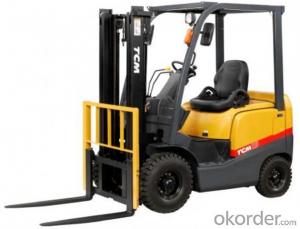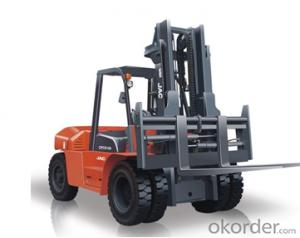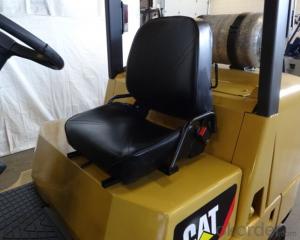FORKLIFT SERIE - BATTERY FORKLIFT - CMAXFE3R16AC
- Loading Port:
- Shanghai
- Payment Terms:
- TT or LC
- Min Order Qty:
- 1 unit
- Supply Capability:
- 1 unit/month
OKorder Service Pledge
OKorder Financial Service
You Might Also Like
Description of forklift:
A forklift truck (also called a lift truck, a fork truck, or a forklift) is a powered industrial truck used to lift and move materials short distances. The forklift was developed in the early 20th century by various companies including the transmission manufacturing company Clark and the hoist company Yale & Towne Manufacturing. Following World War II the use and development of the forklift truck has greatly expanded worldwide. Forklifts have become an indispensable piece of equipment in manufacturing and warehousing operations. In 2013 alone the top 20 manufacturers worldwide posted sales of $30.4 billion with 944,405 machines sold.;and the U.S. forklift market was nearly $33 billion.
A forklift truck being used during World War II
The middle nineteenth century through the early twentieth century saw the developments that led to today's modern forklifts. The forerunner of the modern forklift were manually powered hoists that were used to lift loads. In 1906 the Pennsylvania Railroad introduced battery powered platform trucks for moving luggage at their Altoona, Pennsylvania train station. World War I saw the development of different types of material handling equipment in the United Kingdom by Ransomes, Sims & Jefferies of Ipswich. This was in part due to the labor shortages caused by the war. In 1917 Clark in the United States began developing and using powered tractor and powered lift tractors in their factories. In 1919 the Towmotor Company, and Yale & Towne Manufacturing in 1920, entered the lift truck market in the United States. Continuing development and expanded use of the forklift continued through the 1920s and 1930s. The introduction of hydraulic power and the development of the first electric power forklifts, along with the use of standardized pallets in the late 1930s, helped to increase the popularity of forklift trucks.
The start of World War II, like World War I before, spurred the use of forklift trucks in the war effort. Following the war, more efficient methods for storing products in warehouses were being implemented. Warehouses needed more maneuverable forklift trucks that could reach greater heights and new forklift models were made that filled this need. For example, in 1954 a British company named Lansing Bagnall, now part of KION Group, developed what was claimed to be the first narrow aisle electric reach truck.The development changed the design of warehouses leading to narrower aisles and higher load stacking that increased storage capability.During the 1950s and 1960s operator safety became a concern due to the increasing lifting heights and capacities. Safety features such as load back rests and operator cages, called overhead guards, began to be added to forklifts produced in this era. In the late 1980s ergonomic design began to be incorporated in new forklift designs to improve operator comfort, reduce injuries and increase productivity. During the 1990s exhaust emissions from forklift operations began to be addressed which led to emission standards being implemented for forklift manufacturers in various countries. The introduction of AC power forklifts, along with fuel cell technology, are also refinements in continuing forklift development In 2011, the size of the forklift manufacturing industry was nearly $27 billion.
Technical data of forklift:
1KG=2.2LB 1INCH=25.4MM
Mast table FE3R16AC | Capacity table(kg) c=500mm | Truck | |||||||
| Designation | Lift height | Free lift | Closed mast height | Extended mast height | Forward backward tilt | FE3R16AC | Width | Truck | |
| h3 mm | h2 mm | h1 mm | h4 mm | α/β(°) | Without sideshift | With sideshift | mm | mm | |
| two-stage | 2500 | 145 | 1650 | 3420 | 3/6 | 1600 | 1600 | 1030 | 858 |
| 2700 | 145 | 1850 | 3620 | 3/6 | 1600 | 1600 | 1030 | 858 | |
| 3000 | 145 | 2000 | 3920 | 3/6 | 1600 | 1600 | 1030 | 858 | |
| 3300 | 145 | 2150 | 4220 | 3/6 | 1600 | 1500 | 1030 | 858 | |
| 3600 | 145 | 2300 | 4520 | 3/6 | 1500 | 1400 | 1030 | 858 | |
| 4000 | 145 | 2500 | 4920 | 3/6 | 1350 | 1250 | 1030 | 858 | |
| 4300 | 145 | 2650 | 5220 | 3/6 | 1200 | 1100 | 1030 | 858 | |
| 4500 | 145 | 2750 | 5420 | 3/6 | 1050 | 900 | 1030 | 858 | |
| two-stage full free | 2500 | 1200 | 1650 | 3420 | 3/6 | 1600 | 1600 | 1030 | 858 |
| 2700 | 1300 | 1850 | 3620 | 3/6 | 1600 | 1600 | 1030 | 858 | |
| 3000 | 1500 | 2000 | 3920 | 3/6 | 1600 | 1500 | 1030 | 858 | |
| 3300 | 1700 | 2150 | 4220 | 3/6 | 1600 | 1500 | 1030 | 858 | |
| 3600 | 1800 | 2300 | 4520 | 3/6 | 1500 | 1400 | 1030 | 858 | |
| 4000 | 2000 | 2500 | 4920 | 3/6 | 1350 | 1250 | 1030 | 858 | |
| three-stage | 4000 | 1300 | 1895 | 4920 | 3/6 | 1250 | 1150 | 1030 | 858 |
| 4300 | 1400 | 1905 | 5220 | 3/6 | 1150 | 1050 | 1030 | 858 | |
| 4500 | 1500 | 1955 | 5420 | 3/6 | 1050 | 950 | 1030 | 858 | |
| 4800 | 1600 | 2055 | 5720 | 3/6 | 900 | 750 | 1030 | 858 | |
| 5000 | 1700 | 2105 | 5920 | 3/6 | 750 | 600 | 1030 | 858 | |
| Identification | Manufacturer’s type designation | FE3R16AC | |
| Drive:electric(battery or mains),diesel, petrol gas,manual | electric | ||
| Type of operation : hand ,pedestrian ,standing, seated,order-picker | seated | ||
| Load Capacity /rated load | Q (kg) | 1600 | |
| Load center distance | C(mm) | 500 | |
| Load distance, centre of drive axle to fork | X(mm) | 330 | |
| Wheelbase | y(mm) | 1207/1304 | |
| Weights | Service Weight ind,battery(see line 6.5) | Kg | 3034 |
| Axle loading, laden front/rear | Kg | 4170/464 | |
| Axle loading, unladen front/rear | Kg | 1214/1820 | |
| Wheels, Chassis | Tyres:solid rubber, superelastic, pneumatic, polyurethane) | SE | |
| Tyre size, front | 457x178x308 | ||
| Tyre size, rear | 18x7-8 | ||
| Wheels, number front/rear(x=driven wheels) | 2x/1x | ||
| Track width,front | b10(mm) | 884 | |
| Track width,rear | b11(mm) | - | |
| Basic Dimensions | Mast/fork carriage tilt forward/backward | α/β(°) | 3/6 |
| Lowered mast height | h1(mm) | 2150 | |
| Free lift | h2(mm) | 145 | |
| Lift height | h3(mm) | 3300 | |
| Extended mast height | h4(mm) | 4159 | |
| Overhead load guard height | h6(mm) | 1990 | |
| Seat height/standing height | h7(mm) | 950 | |
| Coupling height | h10(mm) | 432 | |
| Overall length | l1(mm) | 1869 | |
| Length to face of forks | l2(mm) | 1869 | |
| Overall width | b1/b2(mm) | 1060 | |
| Fork dimensions | s/e/l(mm) | 100x35x920 | |
| Fork carriage width | b3(mm) | 980 | |
| Ground clearance,laden, under mast | m1(mm) | 100 | |
| Ground clearance, center of wheelbase | m2(mm) | 110 | |
| Aisle width for pallets 1000x1200 crossways | Ast(mm) | 3069 | |
| Turning radius | Wa(mm) | 1539 | |
| Performance Data | Travel Speed, laden/unladen | km/h | 10/10 |
| Lift speed, laden/unladen | mm/s | 240/400 | |
| Lowering speed, laden/unladen | mm/s | 400/300 | |
| Gradient performance,laden/unladen S2 30min | % | 10/15 | |
| Service brake | hydr./mech. | ||
| E-Motor | Drive motor rating s2 60min | kw | 5 |
| Lift motor rating at s3 15% | kw | 7.5 | |
| Battery voltage, norminal capacity K5 | V/Ah | 48/400 | |
| Battery weight | kg | 665 | |
| Others | Type of drive control | AC | |
| Operating pressure for attachments | MPa | 14.5 | |
| Sound level at driver’s ear according to EN12053 | dB(A) | 75 |
Images of forklift:



FAQ of forklift:
Q: What’s the function of forklift?
A: A forklift truck (also called a lift truck, a fork truck, or a forklift) is a powered industrial truck used to lift and move materials short distances. The forklift was developed in the early 20th century by various companies including the transmission manufacturing company Clark and the hoist company Yale & Towne Manufacturing. Following World War II the use and development of the forklift truck has greatly expanded worldwide. Forklifts have become an indispensable piece of equipment in manufacturing and warehousing operations.
Q: What’s the general operations of forklift:
A: Forklift cab with control layout.
Forklifts are rated for loads at a specified maximum weight and a specified forward center of gravity. This information is located on a nameplate provided by the manufacturer, and loads must not exceed these specifications. In many jurisdictions it is illegal to remove or tamper with the nameplate without the permission of the forklift manufacturer.
Q: What are the Forklift safety Standards?
A: 1, Forklift safety is subject to a variety of standards world wide. The most important standard is the ANSI B56—of which stewardship has now been passed from the American National Standards Institute (ANSI) to the Industrial Truck Standards Development Foundation after multi-year negotiations. ITSDF is a non-profit organization whose only purpose is the promulgation and modernization of the B56 standard.
2, Other forklift safety standards have been implemented in the United States by the Occupational Safety and Health Administration (OSHA) and in the United Kingdom by the Health and Safety Executive.
3, Driver safety: In many countries forklift truck operators must be trained and certified to operate forklift trucks. Certification may be required for each individual class of lift that an operator would use.
- Q: How does the fork of a forklift know that there is no balance
- There are two kinds of fork balances, one is empty and one is heavy. Empty balance: flat. Stop when the fork is placed a few centimeters off the ground. Eyemeasure or measure, the tip of the cargo fork is separated from the ground. Can be measured.
- Q: What is the tonnage of a few tons of forklifts?
- Most of the ports are not bad, and they buy a lot of forklifts. There are more than 10 tons of forklifts in the harbor, as well as the container size forklift
- Q: The operation specification of forklift truck
- It is strictly forbidden to drive people and drink and drive. No eating and small talk during the journey; No mobile phone calls on the way. Before the vehicle is used, it should be strictly inspected, strictly forbidden to go out of the car, not to be forced through the dangerous or potentially dangerous section of the road
- Q: What are some of the common failures of forklifts?
- Forklifts cannot be started with the following conditions: 1, the battery without electricity Failure of starter The key switch is bad 4, the oil pump does not supply oil 5, there was no oil tank 6, no oil 7, the crankshaft lock The engine was completely scrapped
- Q: How is the forklift card checked online?
- The forklift card is issued by the bureau of quality supervision, and after 40 days, you can check the Internet and check the Internet. Enter the "state quality technology supervision bureau" in baidu. You will see the website "national quality supervision and inspection and quarantine portal, http:// www.aqsiq /". When you go to the front page of your site, find a one-stop shop online.
- Q: People leave the forklift and do what and what to pay attention to when parking
- Before leaving the forklift, remove the cargo fork completely, hold the hand brake and remove the key of the switch. Press the emergency isolation switch. If you park the forklift on a slope, you must plug the wheels.
- Q: How do you tell if a forklift is retrofitted?
- To identify whether the forklift is refurbished: The new forklift has only the sole manufacturer's certificate, which has engine Numbers, serial Numbers, production dates, and old forklifts. Look up from beneath the car, such as no sludge in the sag, paint thinner, door frame without wear and walk it sounds small, small gap control system, the basic is new. The most common thing is to look at the colour and shine of the tires, and the rear tire color and gloss are all dim. It is also possible to distinguish between the tread of the tread and the tread of the tread, and the new tyres are not as smooth as the new ones. Renovation tire tire body is compared commonly coarse, tire side have traces, a sign of retreaded tire are mostly to the poster, with fingernails scratching the logo, can pick off will be retreaded tire.
- Q: What are the types of battery forklifts
- Electric picking forklift under certain conditions (e.g., the supermarket distribution center), don't need the whole pallet shipment, but according to the order picking multiple varieties of goods a tray, this part is called selection. According to the height of the chosen goods, the power picking forklift can be divided into low order picking forklift (2.5-meter) and medium-high picking forklift truck (up to 10 meters). Load capacity 2.0 ~ 2.5 tons (low), 1.0 ~ 1.2 ton (high, with bridge lift). Low driving 3 to stack forklift Usually equipped with a three-way stacking head, do not need to forklift, pallet fork rotation can be achieved on both sides of the stacking and pickup of goods, channel width is 1.5 ~ 2.0 meters, hoisting height can reach 12 meters. The bridge of the forklift is always on the ground, and is designed to improve the operating view limit, which is used to improve the operating condition of a height below 6 meters.
- Q: How many years can you use a forklift battery
- Depends on intensity of use, can generally use two to three years, its charge number in about five hundred times at the same time should pay attention to not put on electric net recharge, also can't overcharge, otherwise affect service life
- Q: Why is the forklift water tank heating?
- For many reasons: there are plenty of pump is out of order, have a plenty of water pump belt is loose, have a plenty of the tank wall, also have a plenty of water pump clogged, still have a plenty of cylinder cushion ate (bad), with the summer brought out the temperature cut-off valve, cut-off valve is broken also affects the water temperature. Look at you.
Send your message to us
FORKLIFT SERIE - BATTERY FORKLIFT - CMAXFE3R16AC
- Loading Port:
- Shanghai
- Payment Terms:
- TT or LC
- Min Order Qty:
- 1 unit
- Supply Capability:
- 1 unit/month
OKorder Service Pledge
OKorder Financial Service
Similar products
Hot products
Hot Searches
Related keywords

























